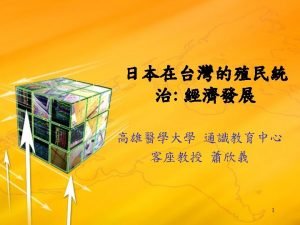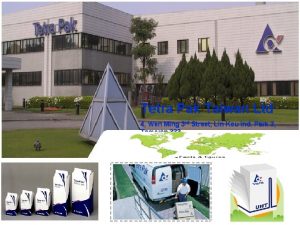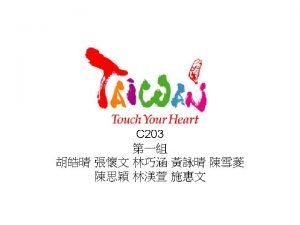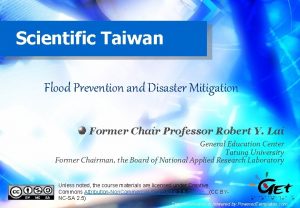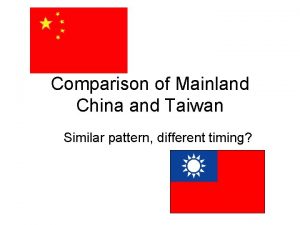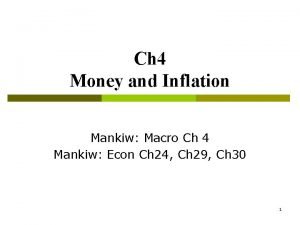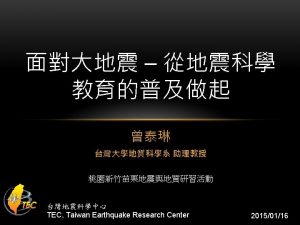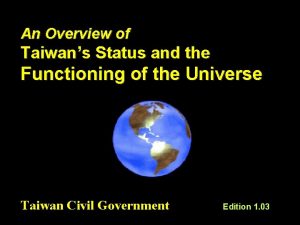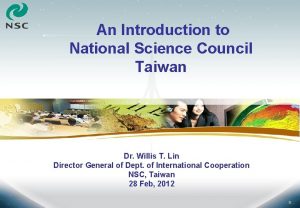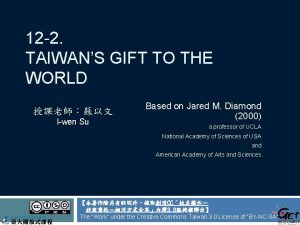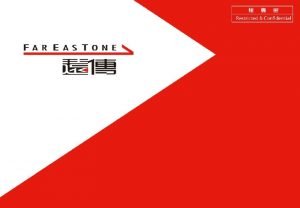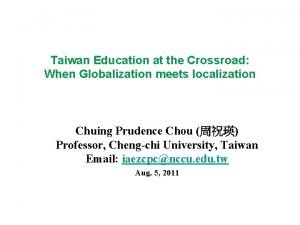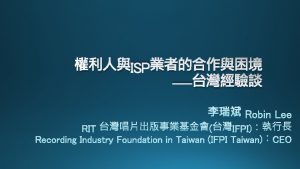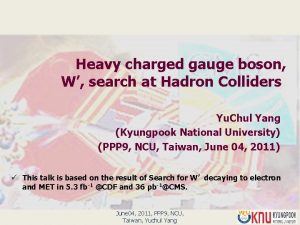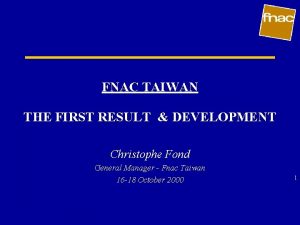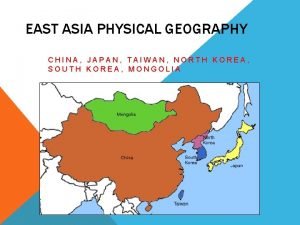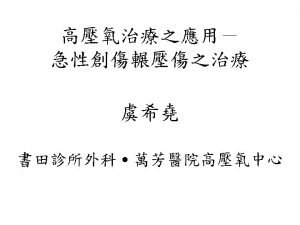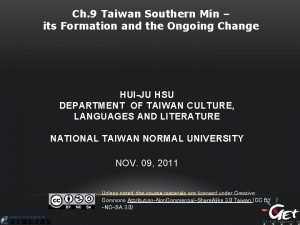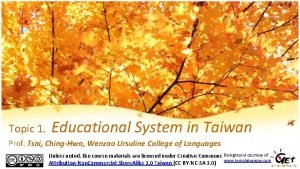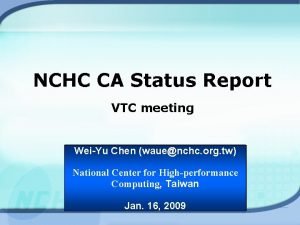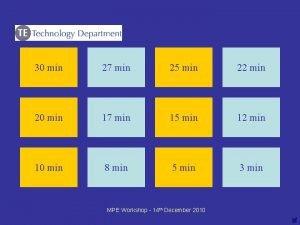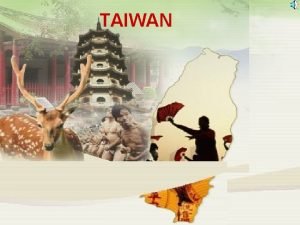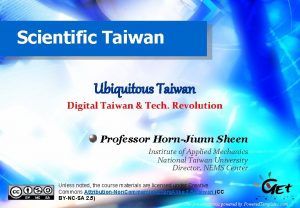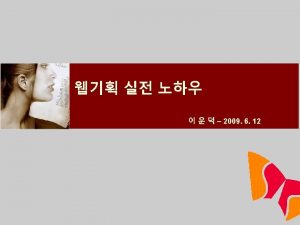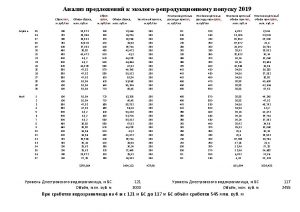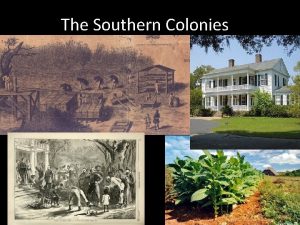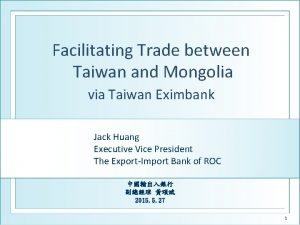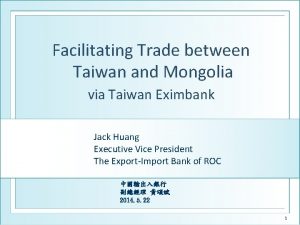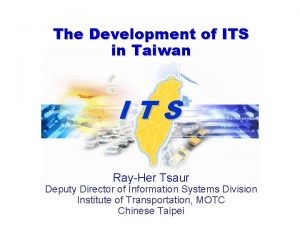Ch 9 Taiwan Southern Min its Formation and































![1. PHONONOGICAL LEVEL I. word SM Mandarin new SM 環 (“surrounding”) [khuan] [huan] 概 1. PHONONOGICAL LEVEL I. word SM Mandarin new SM 環 (“surrounding”) [khuan] [huan] 概](https://slidetodoc.com/presentation_image_h/1da49aee543dfc02b260d8b76ebdfe83/image-32.jpg)


![[-p] Ø [-t] [-p, -t, -k] [-k] NTNU Hui-ju Hsu [-p] Ø [-t] [-p, -t, -k] [-k] NTNU Hui-ju Hsu](https://slidetodoc.com/presentation_image_h/1da49aee543dfc02b260d8b76ebdfe83/image-35.jpg)













- Slides: 48

Ch. 9 Taiwan Southern Min – its Formation and the Ongoing Change HUI-JU HSU DEPARTMENT OF TAIWAN CULTURE, LANGUAGES AND LITERATURE NATIONAL TAIWAN NORMAL UNIVERSITY NOV. 09, 2011 【本著作除另有註明外,採取創用CC「姓名標示 -非商業性-相同方式分享」台灣 3. 0版授權釋出】 The “Work” under the Creative Commons Taiwan 3. 0 License of “BY-NC-SA”.

IN THIS TALK • Background • Southern Min -- the complicated tone system and tone sandhi rules • The Formation of Taiwan Southern Min -- contact between Southern Min dialects -- contact with other languages in Taiwan • The Ongoing Change of Taiwan Southern Min

BACKGROUND Southern Min, Mandarin – the two major languages in Taiwan • Southern Min (Taiwanese, Tai-gi 台語, Holo 河洛, 福佬, Hokkien ) – demographically predominant (about 75% of the population) • Mandarin – politically predominant mutually unintelligible!

MANDARIN AND MIN -- NOT MUTUALLY INTELLIGIBLE Mandarin Min Wiki Wu Yue (original); Gohu 1 er (SVG)

MAJOR LANGUAGES IN TAIWAN AT DIFFERENT PERIODS (THE BOLD PRINT INDICATES THE NEWLY ARRIVED LANGUAGES IN THAT PERIOD. ) NTNU Hui-ju Hsu

NTNU Hui-ju Hsu Southern Min Waishengren Language Southern Min Various Mandarin Immigration time 17 th-19 th century mainly 1945 -1949 Population*(% of 73% Taiwan) Immigration Type 13% voluntary; involuntary; politically economically driven, driven *At the time after World War II when Mandarin was officially introduced into Taiwan. The language-ethnic mapping (eg. Waishengren-Mandarin, Southern Min-Southern Min) has been disrupted mainly due to the Mandarin-only policy.

TONE • Tone: “A pitch that conveys part of the meaning of a word. ” Ladefoged, Peter. 2006. A Course in Phonetics, 5 th ed.

MANDARIN TONES ma 1 -- mother ma 2 – hemp ma 3 – a horse ma 4 – to scold Wiki Everlong

SOUTHERN MIN TONES checked tone (entering tone): performed as a short syllable T 1 T 2 T 3 T 4 T 5 T 7 T 8 Adapted from Wiki Herr Klugbeisser

TONE SANDHI (IN • the change of tone that occurs in some languages when different tones come together in a word or phrase (http: //en. wikipedia. org/wiki/Tone_sandhi)

TONE SANDHI • Mandarin Tone Sandhi : T 3+T 3 T 2+T 3 eg. 雨(yu 3)傘(san 3) 雨傘(yu 2 san 3) an umbrella • eg. 老(lao 3)闆(ban 3) 老闆(lao 2 ban 3) the store owner

SOUTHERN MIN TONE SANDHI • 1. regular tone sandhi (一般變調) -- 舒聲調 (for non checked syllable) -- 入聲調 (for checked syllable) • 2. special tone sandhi (特殊變調) Only regular tone sandhi will be introduced in this presentation.

Wiki user: A-cai


THE FORMATION OF TAIWAN SOUTHERN MIN • Two major mechanisms -- contact between the dialects of Southern Min -- contact with other languages, both local and foreign ones, in Taiwan

Southern Min: the language spoken in the southern part of Min(閩, or 福建 Fujian) Province The two major SM dialects to Taiwan: Tsaun-tsiu (泉州) and Tsiang-tsiu (漳州) dialect Tsuan-tsiu Tsiang Taiwan Adapted from Wiki Wyunhe

Orange: Tsuan-tsiu ( 泉州) dialect Yellow: Tsiang-tsiu ( 漳州) dialect note: blue– Hakka (客家) 台灣言語分布圖:小川尚義, 《日台大辭典》附錄。 Published by 台灣總督府,1907。

SOME EXAMPLES OF THE TSAUN/TSIANG (泉/漳) DIALECTAL DIFFERENCE NTNU Hui-ju Hsu

Tsiang-tsiu (漳州) Southern Min/ Tsuan-tsiu (泉州) Southern Min pro-Tsiang Southern Min/ pro-Tsuan Southern Min (neither “pure” Tsiang, nor “pure” Tsuan dialects maintained in Taiwan)


SOME EXAMPLES* Taipei SM dialect – pro Tsuan -tsiu NTNU Hui-ju Hsu Yi-lan SM dialect – pro Tsiang -tsiu Subtle variations may exist within each dialect though not discussed in a intro-level talk.

THE FORMATION OF TAIWAN SOUTHERN MIN • Two major mechanisms -- contact between the dialects of Southern Min -- contact with other languages, both local (Austronesian) and foreign ones, in Taiwan

THE CONTACT BETWEEN SOUTHERN MIN AND OTHER LANGUAGE IN TAIWAN • Languages other than Southern Min in Taiwan: -- Austronesian languages (the aboriginal languages) -- Spanish (mainly in northern Taiwan) (1626 -1642) -- Dutch (mainly in Tainan) (1624 -1662) -- Japanese (1895 -1945)

SOME LOANWORDS IN TAIWAN SOUTHERN MIN NTNU Hui-ju Hsu

THE ONGOING CHANGE OF TAIWAN SOUTHERN MIN -- MANDARIN INFLUENCE AT PHONOLOGICAL, LEXICAL, AND SYNTACTIC LEVELS

1600 1895 1945 1990 Tsiang-tsiu/ Tsuan-tsiu levelling stablized TSM suppressed new Taiwan Southern Min 1945 -1990: Mandarin the exclusively promoted language; TSM suppressed “Pure” and std. Mandarin highly encouraged. Contact between TSM and Mandarin, though not avoidable, not encouraged. Switching between or mix of these two languages being stigmatized. Mandarin loanwords into TSM > the other way around NTNU Hui-ju Hsu

BACKGROUND OF TSM ONGOING CHANGE • The Mandarin only movement leads to a language shift from Taiwan Southern Min (and other local languages) to Mandarin. -- Mandarin replaces Southern Min (and other local languages) in most domains in Taiwan. -- Taiwanese people gradually loss their Southern Min ability; many young people become semi-speakers of Southern Min or even Mandarin monolingual.

• In the 1990 s, encouraged by the democratization, Taiwan Southern Min, the ever suppressed predominant local language began to be revitalized.

• Revitalized Taiwan Southern Min New TSM 新台語 (note: my wording!!)

• New TSM – Mandarin influenced (1) Phonological level (2) Lexical level (3) Syntactic level

DATA The Taiwan Southern Min data from Mandarin-Southern Min Bilingual Spontaneous Monologue Corpus 18 informants -- self-claimed Mandarin-Taiwan Southern Min bilinguals -- two age groups 10 old: 1938 -1953 born (50 -65 yrs old when recorded) 8 young: 1968 -1983 born (20 -35 yrs old when recorded)
![1 PHONONOGICAL LEVEL I word SM Mandarin new SM 環 surrounding khuan huan 概 1. PHONONOGICAL LEVEL I. word SM Mandarin new SM 環 (“surrounding”) [khuan] [huan] 概](https://slidetodoc.com/presentation_image_h/1da49aee543dfc02b260d8b76ebdfe83/image-32.jpg)
1. PHONONOGICAL LEVEL I. word SM Mandarin new SM 環 (“surrounding”) [khuan] [huan] 概 (“general”) [khai] [kai] 航 (“cruising”) [phaŋ ] [haŋ] 標 (“a label”) [phiao] [piao] NTNU Hui-ju Hsu

1. PHONOLOGICAL LEVEL II. • Taiwanese-Mandarin consonant gap was nearly leveled; new Taiwan Southern Min tends to converge to Mandarin system.

NTNU Hui-ju Hsu
![p Ø t p t k k NTNU Huiju Hsu [-p] Ø [-t] [-p, -t, -k] [-k] NTNU Hui-ju Hsu](https://slidetodoc.com/presentation_image_h/1da49aee543dfc02b260d8b76ebdfe83/image-35.jpg)
[-p] Ø [-t] [-p, -t, -k] [-k] NTNU Hui-ju Hsu

NTNU Hui-ju Hsu

2. LEXICAL LEVEL– MANDARIN INFLUENCED • Japanese loanwords largely replaced by their Mandarin counterparts • TSM-Mandarin competing items Mandarin wins out.

2. LEXICAL LEVEL NTNU Hui-ju Hsu -- JAPANESE LOANWORDS PHASING OUT old SM (in Tai-lo) (translation) Japanese (in Japanese Romanization) Mandarin (in pinyin) ai satsu (to greet) あいさつ 挨 拶 aisatsu 打 da zhao hu pha tsio ho thakhusi (a taxi) タクシー takushi 計 程 車 ji cheng che 計 basu (a bus) バス basu 公 車 gong che 公 ootoobai (a motorcycle) オードバイ otobai tsui to tsui 水 道 水 (tap water) すいどうすい 水 道 水 suidousui 自 zi lai shuei tsu lai tsui lip inn 入 院 (hospitalization) にゅういん 入 院 nyuin 住 住 機 ji 招 new SM (in Tai-lo) 呼 車 che 來 水 院 zhu yuan 打 招 呼 程 車 ke ting tshia 車 gong tshia 機 車 ki tshia 自 來 院 tua inn 水

2. LEXICAL LEVEL -- TRADITIONAL SM TERM WEAKENING

3. SYNTACTIC LEVEL -- MANDARIN INFLUENCED – I. Traditional Southern Min (in Tai -lo)— 2 types of Q patterns Mandarin (in pinyin) – (1) kam-question – intra-sentential Q marker zhe shi ni de ma 這 kam 是 你 的? this is yours Q (ma)? tse kam si li this Q e yours Sentential final Q marker “ma” 這 是 你 的 嗎? New TSM 這 (2) sioh-question – sentential final Q marker “sioh” 是 你 的 嗎? tse si li e ma this is yours Q(ma) 這 是 你 的 sioh? tse si li e sioh this is yours Q (sioh) -- only the sentential final Q marker pattern left -- the Q marker sioh replaced by Mandarin counterpart ma

ONE MORE EXAMPLE “I could not find you”. Tradiational SM (in Tai-lo) 我 找 你 無。(gua tshe li bo. ) I find you Neg. ---------------------Mandarin (in Pinyin) 我 找 不 到 你! (wuo zhao bu dao ni. ) I find NEG Com. You ----------------------New TSM (in Tai-lo) 我找 無 你。(gua tshe bo li. ) I find NEG you.

• Following are some items with their traditional SM pronunciation. Please try to predict the new pronunciation of them in the future.

Traditional Southern Min New TSM 研 (“research”) gen ? 心(“heart”) sim ? 合(“to close”) hap ? 立 (“to stand”) NTNU Hui-ju Hsu lip ?

Traditional Southern Min New TSM (predicted) 研(“research”) gen en, ken, ien… 心(“heart”) sim sin, sing… 合(“to close”) hap ha, hak, hat… 立 (“to stand”) lip lik, lit… NTNU Hui-ju Hsu

• Thank you!!

COPYRIGHT DECLARATION Work Licensing Author/Source Wiki Wu Yue (original); Gohu 1 er (SVG) http: //en. wikipedia. org/wiki/File: Map_of_sinitic_language s-en. svg 2011/11/16 visited Wiki Everlong http: //commons. wikimedia. org/wiki/File: Pinyin_Tone_Ch art. png 2011/11/16 visited Wiki Herr Klugbeisser http: //en. wikipedia. org/wiki/File: Taiwanese_tones. png 2011/11/16 visited Wiki user: A-cai http: //commons. wikimedia. org/wiki/File: Amoy_tones. JP G 2011/11/16 visited

COPYRIGHT DECLARATION Work Licensing Author/Source Wiki Wyunhe http: //commons. wikimedia. org/wiki/File: Map_of_sinitic_d ialect_-_English_version. svg 2011/11/16 visited Adapted from Wiki Wyunhe http: //commons. wikimedia. org/wiki/File: Map_of_sinitic_d ialect_-_English_version. svg 2011/11/16 visited 台灣言語分布圖:小川尚義《日台大辭典》附錄。 Published by 台灣總督府,1907。 台灣語言方言分佈圖:洪惟仁《台北地區閩南語的方言 類型與方言分區》p. 54,http: //goo. gl/E 0 FEb from http: //www. uijin. idv. tw/ and used subject to the fair use doctrine of the Taiwan Copyright Act Article 50 by NTU OCW

COPYRIGHT DECLARATION Work p. 5, 6, 14, 18, 21, 24, 26, 32, 34, 35, 36, 38, 43, 44 p. 7 Licensing Author/Source NTNU Hui-ju Hsu 繪製 (2011) Ladefoged, Peter. 2006. A Course in Phonetics, 5 th ed. and used subject to the fair use doctrine of the Taiwan Copyright Act Article 50 by NTU OCW
 Formation initiale vs formation continue
Formation initiale vs formation continue Colonialism and development: korea, taiwan, and kwantung
Colonialism and development: korea, taiwan, and kwantung I comb its hair and love its shining eyes
I comb its hair and love its shining eyes Its halloween its halloween the moon is full and bright
Its halloween its halloween the moon is full and bright When a train increases its velocity, its momentum
When a train increases its velocity, its momentum Sunny rainy snowy windy cloudy
Sunny rainy snowy windy cloudy If its a square it's a sonnet summary
If its a square it's a sonnet summary Its not easy but its worth it
Its not easy but its worth it Taiwan earthquake
Taiwan earthquake Taiwan drama ptt
Taiwan drama ptt Tetra pak taiwan
Tetra pak taiwan Where is taiwan
Where is taiwan Taiwan flood
Taiwan flood Taiwan earthquake
Taiwan earthquake Providence university taiwan ranking
Providence university taiwan ranking Taiwan earthquake
Taiwan earthquake Taiwan size comparison
Taiwan size comparison 4. velocity and the quantity equation
4. velocity and the quantity equation Taiwan earthquake
Taiwan earthquake Taiwan id card
Taiwan id card National science council taiwan
National science council taiwan Taiwan's gift to the world
Taiwan's gift to the world Taiwan personal identification number
Taiwan personal identification number Allen gartner
Allen gartner Taiwan gnp
Taiwan gnp Tipa taiwan
Tipa taiwan Taiwan earthquake
Taiwan earthquake Lf logistics taiwan
Lf logistics taiwan Taiwan earthquake
Taiwan earthquake Ppp9 taiwan
Ppp9 taiwan Christophe fond
Christophe fond Manager or supervisor higher
Manager or supervisor higher Physical geography east asia
Physical geography east asia Crush syndrome
Crush syndrome Taiwanese mandarin
Taiwanese mandarin Taiwan earthquake
Taiwan earthquake Wow prime taiwan
Wow prime taiwan Educational system in taiwan
Educational system in taiwan Ftse4good tip taiwan esg index
Ftse4good tip taiwan esg index Taiwan glass ind corp
Taiwan glass ind corp Splunk timechart
Splunk timechart Taiwan earthquake
Taiwan earthquake Taiwan fcm
Taiwan fcm Mom loves taiwan association
Mom loves taiwan association Wei yu taiwan host
Wei yu taiwan host Taiwan 2d myanmar
Taiwan 2d myanmar Fmcg taiwan
Fmcg taiwan Taiwan energy efficiency label
Taiwan energy efficiency label Introduce taiwan to foreigners
Introduce taiwan to foreigners

